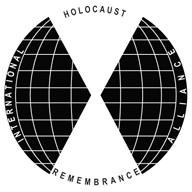“We share a commitment to commemorate the victims of the Holocaust and to honour those who stood against it.”
-- Declaration of the Stockholm International Forum on the Holocaust
 INTERNATIONAL HOLOCAUST REMEMBRANCE ALLIANCE
INTERNATIONAL HOLOCAUST REMEMBRANCE ALLIANCE
“We share a commitment to commemorate the victims of the Holocaust and to honour those who stood against it.”
-- Declaration of the Stockholm International Forum on the Holocaust
In general, teaching about the Holocaust should:
These aims can be clearly seen in the following definitions of the Holocaust:
Under the cover of the Second World War, for the sake of their "new order," the Nazis sought to destroy all the Jews of Europe. For the first time in history, industrial methods were used for the mass extermination of a whole people. Six million were murdered, including 1,500,000 children. This event is called the Holocaust.
The Nazis enslaved and murdered millions of others as well. Gypsies, people with physical and mental disabilities, Poles, Soviet prisoners of war, trade unionists, political opponents, prisoners of conscience, homosexuals, and others were killed in vast numbers.
Imperial War Museum, London, UK
The Holocaust refers to a specific genocidal event in twentieth-century history: the state-sponsored, systematic persecution and annihilation of European Jewry by Nazi Germany and its collaborators between 1933 and 1945. Jews were the primary victims -6 million were murdered; Gypsies, the handicapped, and Poles were also targeted for destruction or decimation for racial, ethnic, or national reasons. Millions more, including homosexuals, Jehovah's Witnesses, Soviet prisoners of war, and political dissidents, also suffered grievous oppression and death under Nazi tyranny.
United States Holocaust Memorial Museum, Washington, D.C., USA
The Holocaust was the murder of approximately six million Jews by the Nazis and their collaborators. Between the German invasion of the Soviet Union in the summer of 1941 and the end of the war in Europe in May 1945, Nazi Germany and its accomplices strove to murder every Jew under their domination. Because Nazi discrimination against the Jews began with Hitler's accession to power in January 1933, many historians consider this the start of the Holocaust era. The Jews were not the only victims of Hitler's regime, but they were the only group that the Nazis sought to destroy entirely.
Yad Vashem, Jerusalem, Israel
Teaching about the Holocaust can and must be different in various contexts. In order to see the differences between the Holocaust and other genocides, comparisons should be carefully distinguished and similarities also should be articulated.
When teaching about the Holocaust, it is helpful to address three basic questions:
1. Why shall I teach about the Holocaust?
2. What shall I teach about the Holocaust?
3. How shall I teach about the Holocaust?
The first question involves issues of rationale. The second question involves selection of information, while the third question deals with appropriate pedagogical approaches based on the student group. These guidelines do not address the first and third questions. These questions will be addressed in other guidelines.
In addition to history, the Holocaust can also be approached through other disciplines, such as literature, psychology, religious studies, and others.
As national and local commemorative activities are seen to be of value, it is advised to provide educational support to such activities.
The study of the Holocaust must be examined within the context of European history as a whole. We encourage educators to also examine the local context for this history. Educators should provide context for the events of the Holocaust by including information about:
As for the historical themes or topics connected with teaching about the Holocaust, educators might examine the following, among others, when constructing lessons on the Holocaust. As they do so, they may consider this history from the perspectives of the:
1933-1939
1939-1945
Aftermath
The purpose of these guidelines is to strengthen teaching about the Holocaust. The teaching will be different from country to country, from school to school, and from time to time. Therefore, it is understood that it is important to stress the need for self-evaluation of teaching efforts by all educators.